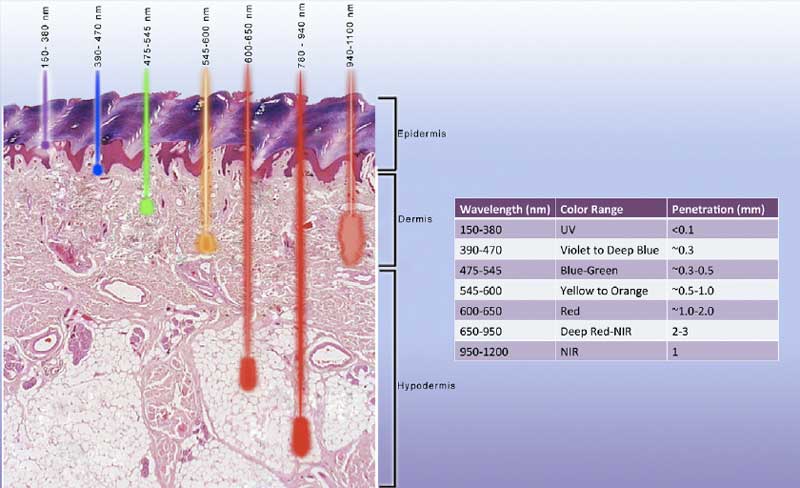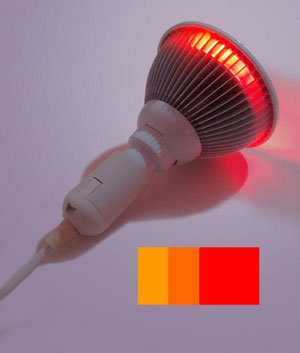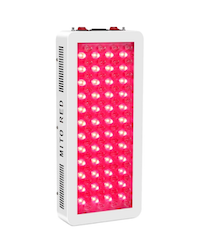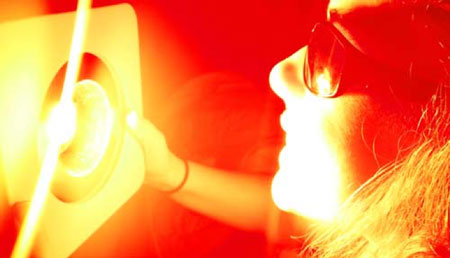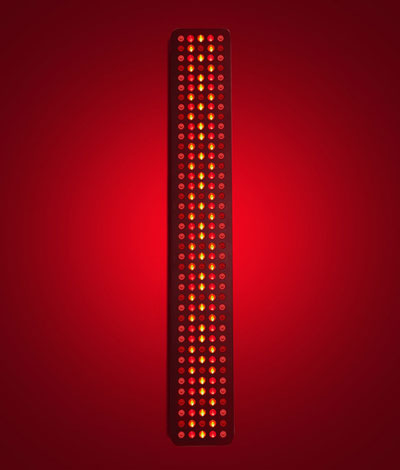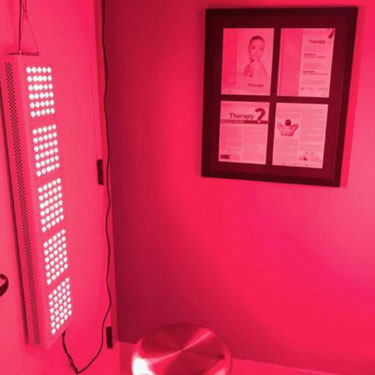The Fascinating Healing Properties of Red Light Therapy: Rapid Healing, Reduce Wrinkles & Rejuvenate Health

If you have been reading my blog for a while, you’ve heard me talk about how sunlight is essential for optimal health. In this article, you will learn how a certain wavelength of light—red light—can have additional benefits of its own, improving health, beauty and overall well-being.
Note: If you're looking for a quick one-page guide showing you what wavelengths of light have been shown to help specific health and wellness issues, be sure to CLICK HERE.
Why Red Light Therapy Improves Your Health, Beauty and Well-Being
I’ve talked about the health and mood benefits of full-spectrum sunlight. I've explained how blue light can impair sleep. I’ve also explored the many benefits of saunas, (that may also use infrared light) for example, aiding the body in detoxification and improving heart health. This article, however, will exclusively look at the scientific literature behind red and infrared devices.
The most common commercial versions of red and infrared light devices are made of LED lights. Therefore, this article will exclude traditional light bulbs, such as incandescent or halogen bulbs. Even though these bulbs emit red light they also emit high amounts of heat and are, therefore, less effective for very specific therapeutic effects than their LED counterparts.
While the LED devices treated in this article emit both red and infrared light, for convenience's sake, this article will call them 'red light devices' that are used for 'red light therapy'.
In addition to exploring the large amounts of scientific evidence on the benefits of red light therapy, I will also explore whether red light therapy has any side-effects, take a look at different red light therapy devices that are sold on the market and help you determine the optimal dosage for your red light therapy sessions.
But first, let's have a look at what exactly red light therapy is and how it differs from full-spectrum sunlight and conventional light bulbs.
The Light Spectrum
Let's first explore the light spectrum from a physics standpoint. When modern physics talks about light, it discusses particles known as 'photons'. Photons are elemental light particles. These photons make up part of the electromagnetic spectrum, in what is called the 'light spectrum'. That light spectrum consists of ultraviolet (UV) light, visible light and infrared light. Red light is part of this visible light spectrum.

When you are standing outside in the sun at noon, the full spectrum of light emitted by the sun consists of UV light, visible light, and infrared light. Hence the term 'full spectrum'.
Within these spectra of UV, visible and infrared light, there are many different wavelengths that all exhibit different biological effects. Red and blue light (which are parts of the visible light spectrum) both have different wavelengths and exhibit very different biological effects.
For example, infrared saunas (that were treated in a previous article) are using a very specific infrared part of the infrared light spectrum.
Blue light helps stimulate the body and can actually impair sleep (as I covered in this article.)
Red light has its own biological and healing properties as I will explore in detail below.
Red light therapy devices also use a part of the infrared light spectrum. But contrary to infrared saunas, the red light therapy devices only use the red and infrared light wavelengths that do not emit any heat. Thus, the effects are different from sunlight or infrared saunas.

Source: Redlightman.com[1]
In the picture displayed above, red light therapy devices use specific wavelengths within the entire red light spectrum that is displayed there and also use the small 'near-infrared' part of the light spectrum, up to the 850nm range.
What Makes Red Light Therapy with LEDs Different
All light wavelengths above 1000nm will produce heat. Therefore, bulbs that use wavelengths above 1000nm cannot be applied close to the body for longer periods of time. For this reason, red light therapy devices use LED lights so that only the most therapeutic wavelengths that do not emit any heat are used.
The fact that red light therapy devices do not emit any heat is advantageous as a lot more red light can be applied to the body for longer periods of time without overheating the body in the process.
Incandescent and halogen bulbs (including heat lamps) exhibit this problem because they emit too much heat.
While the heat coming from infrared saunas has a place in your health toolbox, red light therapy using LED devices has other benefits than infrared saunas.
Both red light therapy and saunas are, thus, great tools to use when improving your health and body.
How LED Red Light Devices Accomplish Their Therapeutic Effects
Contrary to many other types of light bulbs, LEDs can be designed in such a way that they only emit light at very specific preprogrammed therapeutic wavelengths of light.
These therapeutic wavelengths give LEDs another advantage over traditional bulbs. It is currently not possible to have non-LED bulbs peak at specific therapeutic wavelengths.
Incandescent and halogen bulbs, for example, emit a very continuous spectrum of light. Such a continuous light spectrum is not warranted for maximizing the therapeutic benefits of red light therapy—you actually want LED bulbs to exclusively emit light around very specific therapeutic wavelengths, such as 630nm, 660nm, 810nm, etc.
As I stated before, red light therapy devices commonly use both red and infrared wavelengths. These specific wavelengths penetrate very deep into the bodily tissues and are also absorbed very well by the body.
Therefore, light does not only function as visible colors to illuminate your environment, but it actually penetrates into the body and subsequently has biological effects in that body. Consider the following image which shows how deep different types of light wavelengths penetrate into the body:
Source—Saunaspace[2]
As you can see, red light has a greater penetration depth compared to other forms of light, such as UV, blue, green or the longer infrared wavelengths, meaning that the red light can reach deeper bodily tissues.
Other non-red wavelengths cannot reach that deep and cannot affect the underlying tissue in the way that red light therapy does.
The deep tissue penetration also means that red light can have systemic effects on the human body instead of the biological effects remaining localized in one specific area.
The reason for the systemic effects is that deeper tissue penetration means that the photons are taken up in the bloodstream. When photons are carried through the bloodstream those photons can be transferred to other tissues as well and have positive biological consequences there.
Because LEDs can be made in such a way that they emit very specific light wavelengths (such as 630nm or 670nm) these LEDs have other advantages. Red light therapy devices aim to affect the mitochondria throughout the body. Mitochondria are the energy-producing units of our cells. Improving mitochondrial function will improve the overall health of your body.
Not all wavelengths of red and infrared light are optimally absorbed by the mitochondria. By targeting the LEDs towards a few very therapeutic wavelengths, maximal absorption is accomplished.
Therefore, if you were to choose wavelengths that are not optimal, the energy would be mostly wasted. Traditional bulbs such as incandescent or halogen use a lot of these intermediary wavelengths that do not have any proven therapeutic effects because they do not emit enough light at the very specific wavelength peaks.
Now that I've established that red light therapy devices using LEDs have unique technological possibilities, let's consider the many benefits that red light therapy can have for your life. Red light therapy offers many benefits: improving your health, beauty and well-being.
Red Light and Health
Let's first consider how red light therapy can improve your health. To be specific, red light therapy can decrease inflammation, upgrade thyroid functioning, increase gym performance, boost recovery, and promote optimal testosterone levels. I'll treat these subjects one-by-one.
But first, a quick overview of how light impacts the body. As I have touched on above, the body responds to light—different wavelengths of light create different effects on the body. Light in the range from 600nm to 900nm has been shown to create the biggest biological response (most of this range is encompassed by red light).
The energy from this light is absorbed by the body (as per the graphic above) and through a series of metabolic events this light energy is converted into cellular energy. For example, one benefit is the release of ATP—more ATP in the cell . . . better cellular functioning.
Below, I have listed some of the most common ways red light can help the body heal, recover and improve performance. But if you want a simple one-page guide showing you what wavelengths are best for a particular goal, please download my free report HERE.
Decrease Inflammation
Red light therapy can dramatically lower inflammation levels in the body.[3] This means that red light can be used to treat problems like osteoarthritis, joint injuries, and excessive swelling without any of the side-effects that are commonly associated with inflammation-reducing non-prescription drugs such as NSAIDs.[4]
Exercise therapy and red light therapy actually work synergistically in reducing inflammation, meaning that they improve each other’s effects.[5] So if you're just exercising without taking advantage of red light therapy, you might not reduce localized or systemic inflammation as well as you could. Your injuries could, thus, heal much faster if you decide to integrate red light therapy into your life.
The efficacy of red light therapy for reducing inflammation has been scientifically demonstrated on many different locations of the human body such as the back, neck, shoulders, knees and even the jaw. This means that you can use a red light therapy device—even a small one—to very specifically treat an area that is bothering you.
Inflammation is actually a problem that extends way beyond the health of joints or the recovery from injuries. Many modern diseases, such as cardiovascular disease, obesity, diabetes and cancer are all associated with excessive inflammation levels.[6] This does not mean that inflammation is the single underlying cause of these diseases, but it instead means that inflammation is one important issue related to these diseases.
Inflammation is not always a bad thing. Some activities, such as exercise, temporarily increase inflammation due to damage that is caused to the body. However, when individuals habitually exercise, these activities actually decrease their general inflammation levels in the body.[7]
Red light therapy has the same effect... decreasing elevated inflammation levels to more healthy levels.
Larger (and more expensive) red therapy devices may come in handy when curbing systemic inflammation that is not localized to a specific area of the body. Another previously treated option to reduce systemic inflammation is to use cold therapy.
Upgrade Thyroid Functioning and Fat Loss
Red light therapy can increase thyroid hormones. Thyroid hormones are very important because they are responsible for adequate energy production in the human body. While a lot of different variables are responsible for energy production, the thyroid is one of the most essential body parts responsible for actually creating high energy levels so that you do not feel sluggish.

Source—WebMD[8]
Red light therapy can actually improve hypothyroidism conditions.[9] To achieve this effect, red light therapy should be applied to the thyroid on the body for longer periods of time.[10] Measurable differences can be achieved within a week of daily applications.
The same effect is true for thyroid hormones in healthy individuals who improve their thyroid function as well. A benefit tied to up-regulated thyroid functioning is increased fat loss [11],[12] and higher body temperatures.
Combining red light therapy with exercise increases fat-loss to a greater extent than exercise alone. This is yet another reason why working out in the sunlight is more beneficial than working out indoors under the typical blue-light lighting of a gym.
The average gym simply does not achieve the right light intensity or correct light spectrum that is achieved when working out in the sun.
Getting enough light during the day, even if it's red light therapy on days that you cannot get out in the sun, is also very beneficial for weight loss.[13] However, if you were to choose between sitting inside exposed to a red light therapy device or laying outside in the sun, always choose sunlight because it has many more all-around health benefits.
Increased Performance in the Gym
Red light therapy will also increase your performance in the gym. One of the main mechanisms whereby red light increases performance is by stimulating mitochondria functioning in the human body.
Remember that mitochondria are the main energy producing entities in (human) cells. Red light therapy influences these mitochondria to increase the production of their main energy source called ATP.[14]
Red light therapy not only improves the functioning of the existing mitochondria but also helps create new mitochondria. This means that red light therapy can aid in increasing energy over time because of the new mitochondria.
Red light therapy also has additional performance benefits—increasing the gains from any workout you might complete in the gym.[15] Red light therapy, when combined with exercise, improves muscle size and power to greater extents than exercise alone. This positive effect applies to both strength and endurance gains from workout sessions.
Boost Recovery
Red light therapy stimulates the activity of stem cells which are the basic undifferentiated cells in the body. Stem cells can turn into any cell with a specific function, such as skin cells or muscle cells.[16] Such stem cell activity can consequently decrease levels of general fatigue, meaning you will feel less tired after a workout, because the stem cells are turned into new cells.
Red light therapy also increases recovery after exercise. This means that after applying red light, you can last longer the next workout, use more volume during subsequent workouts and protect yourself from excessive damage that has resulted from previous workouts.[17]
The effects of red light therapy are actually so large that questions have emerged whether red light therapy should be considered doping.[18] In essence, red light therapy might be considered a very healthy unfair advantage for gym performance because red light therapy does not have any serious side effects.
Additionally, red light therapy increases muscle blood flow, preventing excessive scar tissue from forming in the first place.[19] Scar tissue is a common problem associated with injuries. It is related to immobility issues and increases the risk of developing injuries over time.[20]
Tendons that are located near the application area of red light therapy increase their speed of regeneration.[21] The same is true for ligaments—torn ligaments improve their healing when red light therapy is applied.[22]
Another beauty of red light therapy is that it might help prevent injuries from occurring in the first place because of increased blood flow and reduced scar tissue build-up.
Overall, red light therapy can help you recover faster, make you less prone to get injured and heal any current injuries that you have much quicker.
Promote Optimal Testosterone Levels
Optimal hormone functioning actually starts in the brain. Different brain areas, such as the hypothalamus and pituitary gland, are involved in that process. Up until recently, however, it was not known that thyroid function also affects steroid hormone production.[23]
Thus, improving thyroid function will also improve steroid hormone production, such as testosterone. To accomplish this effect, you specifically need to use the red light device on your thyroid.
Optimal testosterone levels are not only important for men, but for women as well. Testosterone in women is linked to sex drive, energy and general levels of well-being.[24] In women, testosterone is produced in the ovaries—while in men, testosterone is produced in the testicles.
In addition to improving steroid functioning through thyroid hormones, red light therapy can also increase steroid hormones such as testosterone by directly stimulating the energy production in organs associated therewith. An example would be testosterone production in the testicles.[25]
Remember that red light can penetrate deeply into the body thereby increasing energy production in specific organs. When the correct dose of red light therapy is applied to the testicles, it might actually increase testosterone levels up to three-fold.[26]
Sadly enough, no such scientific studies have investigated the effects of red light therapy on the ovaries yet.
Red Light and Beauty
In addition to improving general health, red light therapy can also be used for looks and beauty. Red light therapy has proven benefits for increasing skin health, healing wounds and scar tissue, improving oral care and reversing hair loss.
Develop Radiant Skin Health
Nowadays, many people have skin issues and try to cover such issues up with cosmetics or use other invasive treatments that commonly have serious side-effects. Red light therapy has been proven to improve the looks of the skin without resulting in any known side-effects.[27] Red light therapy increases blood flow to the skin thereby increasing the skin's regeneration.
Additionally, red light activates stem cells around the skin which then aids them to proliferate into new skin cells. In turn, many skin processes improve, such as: reducing acne, inhibiting scar tissue in the skin, reducing sunburn, inhibiting striae and even healing burn wounds.[28]
Red light therapy can also improve skin conditions such as rosacea, eczema and psoriasis.
However, even if you don't have any skin issues, red light therapy will still improve the looks of your skin. This skin improvement is achieved through an increase in collagen formation in the skin.
The skin will become tighter and smoother. Wrinkles will be reduced in number and decrease in size. The collagen density of the skin will improve.[29] The feeling of the skin and the complexion of the skin are also enhanced.
This means that even if you're a very healthy 20-year-old woman, red light therapy can improve your beauty without the associated downsides that many commercial cosmetics have. So even if you don't have any scars, the moisture and collagen formation from red light therapy will still surprise you in positive ways.
Enhance Wound Healing
Red light therapy can also aid in healing damaged skin, such as wounds. Wounds are often problematic because they take a long time to heal and might leave scar tissue. Red light therapy enhances the wound healing process even after surgery.[30]
After the wounds are gone, red light therapy can significantly reduce scar tissue formation.[31] Treatments with red light therapy decrease scar tissue in both circumference and thickness.
Prevent and Treat Sunburn Damage
There's also anecdotal evidence that you can use red light therapy to both prevent sunburns and lower the intensity of sunburns.
To prevent sunburns, use red light therapy for a few minutes on the skin before stepping into the sunlight. Red light therapy protects you from sunburns because the infrared light is actually stored in the human body. Venturing into the morning sun, which also contains a high portion of infrared light, can also help you prevent sunburns later that day. The same effect is reached through red light therapy.
To help yourself recover from sunburns, apply red light therapy to the affected areas for just a couple of minutes. Red light therapy accomplishes this effect by improving skin recovery.
Improve Oral Care
Next, red light therapy can be used for oral care. Red light therapy applied to the teeth decreases hypersensitivity of the teeth[32],[33], reduces harmful mouth bacteria[34], heals wounds and gums in the mouth[35] and increases the bone remodeling after teeth damage.[36]
This means that red light therapy can aid good dental practice... working as a holistic method to improve all-around dental care.
To use red light therapy for oral care, the light does not only need to penetrate into the cheeks, but the light needs to reach the teeth as well. You can simply add a few minutes of red light therapy after brushing your teeth every day.
Reverse Hair Loss
Red light therapy can reverse hair loss in both men and women.[37]
This means that red light therapy might be a preferable option before prescription drugs are used to reverse hair loss because these prescription drugs often come with side-effects.
While red light therapy is not a universal solution to hair loss—meaning that it won't work in 100% of the cases—other options such as prescription drugs are not a universally working solution either. Thus, red light therapy is a non-invasive therapy that you could try before attempting to fix hair loss with more invasive options.
Red Light and Well-Being
I've treated the benefits of red light therapy for general health improvements, gym recovery and beauty. Now I'll explore some benefits of red light therapy for general well-being.
Decrease Pain
Red light therapy can decrease perceived levels of pain, even in common diseases like osteoarthritis, back pain and other joint disorders.[38],[39],[40] Red light therapy is also an effective treatment for headaches when applying it to the head.[41] Even chronic pain decreases in intensity after red light therapy.[42]
More research needs to be carried out regarding this topic, but red light therapy seems to be a promising modality to treat different types of pain at different locations of the body.
Mood
When the red light is applied to the skull, it penetrates into the brain. Applying the light for just a few minutes to the brain decreases anxiety and depression.[43]
While such treatments currently do not have any side-effects associated with them, I would advise you to do some research concerning the application parameters before trying red light therapy on the brain.[44]
The best option would be to buy a device that is preconfigured in terms of application variables (light dosage, time of usage and position of use) so that you are assured of the best possible treatment.
Many users of red light therapy actually state that their moods are significantly improved after a red light therapy session.
Plus Many Other Benefits
If you take a deep dive into the published literature on red light therapy, you will soon see that the benefits listed above are only scratching the surface. I decided not to go into all the health benefits of red light therapy to keep this article shorter than a book. But if you wanted to see more of these benefits and which wavelength is best suited to healing potential health issues, be sure to download my free 'Red Light Guide'.
Recommended Red Light Devices—And How To Use Them
In this section, I will first explore the different red light devices that are on the market right now.
Next, I will help you determine the scientifically proven dosages for using any red light therapy device and explain why the dosage is important.
Also - if you are looking for the best deals on a red light device, I have compiled a Red Light Therapy Deals And Discount resource page that you can view HERE.
Different Red Light Therapy Devices
There are several different red light therapy devices on the market today. Sadly, not all of them are high-quality.
As mentioned before, this article will only consider LED red light therapy devices. While not making recommendations on what specific product to buy, I will lay out several options to consider when buying a red light therapy device.
Some LED red light therapy devices actually use a 'proprietary' formula whereby a company does not specify what red or infrared wavelengths they use.
The reason for not specifying the wavelengths of the products is usually to protect their business against competition. I would not recommend such devices because you don't know what wavelengths you're applying to your body.
An analogy can be made to supplements where companies use proprietary blends to stay ahead of the competition—these proprietary supplements also prevent you from precisely knowing what you are putting into your body.
Overall, because you would like to know what kind of light you are putting into your body, it is recommended to only buy red light therapy devices that have specifications (regarding the wavelengths) included along with the device.
For simplicity's sake, this article will distinguish between four different red light therapy devices.
- Small units, costing around $50–150
- Medium-size units, that cost up to $600
- Half-body units, which cost up to $3000
- Full-body red light tanning beds, with prices commonly starting at $10,000
*** Note: I have put together a Red Light Buyer's Guide video which you can watch below. ***
Why Such Big Price Differences? Watts, Joules and Time
Before I expand on the four groups of red light therapy devices, you may be wondering 'Why such a big price difference?' Obviously, the bigger units have more materials, thus, a higher cost. But the key difference between units is power output, or in simple terms, the amount of energy delivered to the body.
Research has shown that around 5–6 joules per centimeter squared is the amount of energy needed for best results. This is total energy. So from this figure, you can calculate how long you need to use the red light on a particular area of the body.
But for this calculation, you need to know the unit's power intensity. This is measured as watts per centimeter squared or W/cm².
Once you have this figure (it will be displayed on the device) then you can multiply the intensity figure by time in seconds to find the total energy output.
For example, using a device with an intensity of 0.1W/cm² for 60 seconds equals 6 joules.
BUT, there is an issue with this intensity figure—this number is the intensity at the surface of the light source. So if the light source is 10cm away from the body, the received energy is much lower than the listed figure.
Some units will break down these numbers and others will not.
For example, the MitoMax Light has a power intensity of 100 milliwatts per cm squared (or 0.1W/cm²) at a distance of 6 inches. So standing 6 inches from the device for 60 seconds equals 6 joules of energy. But an inferior unit for a lower cost may only deliver 0.01W/cm² at 6 inches away, requiring 600 seconds (or 10 minutes) of use to achieve the same result.
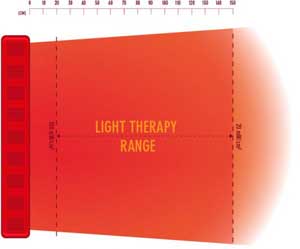
Here you can see the power intensity drop off as the distance increases from the Red Light Man BodyLight. Source - RedLightMan.com
Also, being electronic devices, these red light panels will emit some non-native EMF (nnEMF). To limit your exposure to these harmful fields, you need to lower the total time duration you are exposed to the fields and increase the distance you are from the fields. Another reason why more powerful LEDs (as found in the MitoRed Light panels) are superior for overall health.
Hopefully, this explains why device prices increase dramatically with size and power. Also, total surface size is another factor. If you just purchased a small handheld lower-power unit, it may require a full hour of use to get 5–6 joules into the body. And this surface area may only be the size of a teacup. So, if you want to use this all over the body, it will literally take all day. Not quite practical, right?
But, if you spend more money (and get a larger unit with more LEDs and with more powerful LEDs) then you can receive enough energy to complete the full body in 15 minutes or less perhaps. The performance benefits and time savings are huge if you have the funds to pay for it!
Small Red Light Units
The advantage of small red light therapy devices is that they can easily be applied to all areas of the body. Small devices can be bought for about $50, but they are only recommended if you want to have a cheap way to treat a small injury, like a torn Achilles tendon or an irritating shoulder.
Most of the small red light therapy devices deliver less than 60W of energy and are, therefore, less efficient for full-body treatments or for penetrating very deeply into the body’s tissues.
For example, if you are wanting to use red light for oral health, it's important that you source a device with enough power to penetrate your cheeks. The higher the power density the more light that will reach the tooth, gums and bone. For this, you would want an LED device with a power density above 100mW/cm² to ensure you're still getting enough energy.
Full-body treatments with small devices are inefficient because you would have to move that device every few minutes to achieve a full-body treatment. A full-body treatment would take up to two hours of your time every day.
Another issue is that small red light therapy devices are not always of the highest quality. Make sure to read some reviews online before you buy any product. Alternatively, I have listed a few product examples below:
- Pulsaderm Red LED Hand-held device. This emits red light in the 640–660nm range. Power output is 21–25mW/cm² at the light source. This retails for $100 on Amazon.
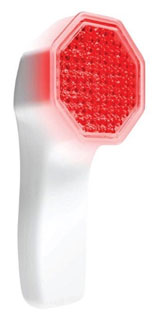
A Small Red Light Therapy Unit. Ideal for Treating Small Injuries.
Source—Pulsaderm.[45]
- Red Light Device Mini by Red Light Man. This has 610, 630 and 670nm bulbs. It is hand-held and portable. It costs under $150. You can also get pure 670nm and 620nm devices in the same size. These have a 20mW/cm² power intensity at 20cm.
Medium-Sized Units
The stronger average-size red light devices will cost between $200 and $600 and deliver between 60W to 120W of pure LED lights. These more powerful red light devices are actually great as a first investment. Because of their light output, these average-size red light therapy devices can also be used for penetrating deeper into the body’s tissue to treat specific organs such as the thyroid, for example.
Some good medium-size units include:
- Red Light Man's Red Light Device. This is a 100W device with wavelengths split equally between 610nm, 630nm, 660nm and 680nm. It costs under $300. You can also get it solely in 670nm light and another version that has infrared light. These units have a solid power intensity of 200mW/cm² at a 10cm distance (1200mW/cm² at the light source).
- MitoRedLight does a more powerful midsize unit. It's their 500w MitoMid Light that emits 660nm and 850nm red light. This 'MitoMid' sells for under $500 (use code ALEX to save a few more dollars) and comes in an easy-to-use form with a large surface area.
However, if you are serious about your health and plan on using a red light therapy device daily, I would recommend considering half-body and full-body units.
LED Red Light Device
Source—Redlightman.com
Half-Body Red Light Devices
Half-body red light therapy units cost between $700 and $3000—consuming up to a 1000W of energy.
Remember that more watts being used also indicates that the device emits more photons. The therapeutic effect of such full-body units is, thus, much stronger.
The higher light output also means that you need less treatment time per session to get a full-body effect. These half-body devices are, therefore, an amazing investment when you want to treat your entire body on a daily habitual basis.
Two popular companies on the market today are by Red Light Man and MitoRedLight. I personally use MitoRed Lights but I will cover both below.
- The Half Body 'Bodylight 2.0' by Red Light Man is a panel comprised of 620nm, 670nm, 760nm and 830nm. So it does have some infrared light as well as the red light. It has a power consumption of 300W and costs $1000. The power intensity rating is 100mW/cm² at 20cm and 20mW/cm² at a whopping 1.5 meters away! This could be fitted out in a sauna, and you would still get good energy exposure even if you weren't right next to the unit.
- MitoRedLight has a few more options in the half-body range. Their MitoMax is a similarly sized 1000W full-body light with 660nm & 850nm light for $760. These units put out 100+mW/cm² at 15cm.
- MitoRedLight also have a high powered (1500w) half-body wall hanging light for over $1049. This is their MitoMEGA device. Which is also available as a combo Red and IR device. At this price, you're getting more power, more lights and faster healing. But it is starting to get expensive!
Full–Body Red Light Therapy Options
Lastly, the market also offers full-body red light therapy tanning beds.
These are generally priced in excess of $15,000 with some brands selling their units up towards $100,000!
Below I have listed possible full-body options:
- Mitogen Red Light Bed. This consists of 10,000 LEDs split between 660nm and 850nm light (the same frequencies as the smaller Joovv device). This has an average power density of 15mW/cm² at the skin's surface. Giving out 20 joules in approximately 11 minutes and 40 joules in approximately 22 minutes.
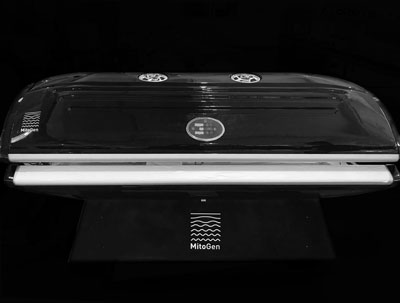
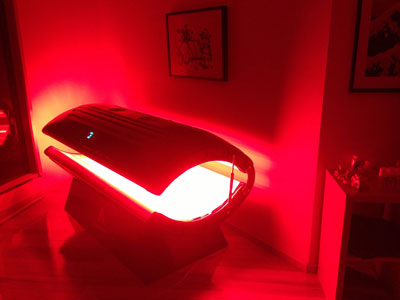
A Full–Body Red Light LED Tanning Bed by Mitogen Energy Medicine
- NovoThor is a full-body device. This costs over $100k. It emits light at 630nm, 660nm and 850nm and has a power density of 17mW/cm² at the skin's surface.
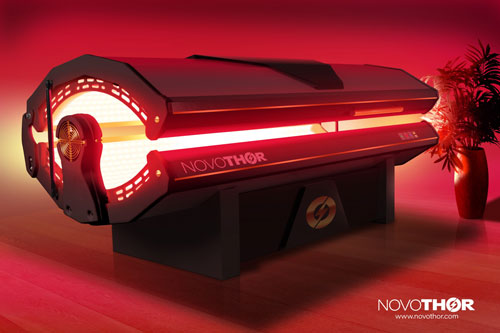
- Multiple MitoMega panels are another option—and this is something I'm slowly working towards with my own setup—is to get multiple panels and build a frame around them so you can stand in the middle. A MitoMega panel costs just over $1000 (after using discount code ALEX), so you could get four of these for a total cost of $4k which is much cheaper than the bed devices.
- Finally there is the PlatinumLED Therapy 'Biomax' range. These units have a 'modular' design so you can connect multiple panels together to build a panel as large as your wallet allows. Plus they sell a stand so you can move these panels around or like I mentioned in the point above, have 4 'walls' so you simply stand in the middle for a full body red light session. This will be a much cheaper option than the beds listed above.
Many of the LED red light devices listed above can be hung on the wall, thereby not costing as much of your precious space as a 'bed' setup would (though you do only get exposure to one side of your body at a time).
A full-body LED red light therapy tanning bed is the ultimate dream. Financially, it may only be a viable option if you buy it with several people or as a company. In a gym, for example, such a device would be a great addition to attract new customers.
The PlatinumLED or MitoRed Mega setups are probably the wiser option. Also, be sure to use discount code ALEX on these panels as you will save 5% off the price.
What Wavelengths Are Best?
It depends. It depends on what you want from your device. There are a plethora of published papers showing the effectiveness of certain red light wavelengths to help the body. I have created a guide that can help you find out what wavelengths are best for a particular problem HERE.
But in the comprehensive meta-analysis on light therapy titled 'The Nuts and Bolts of Low-Level Laser (Light) Therapy'[52], the researchers stated:
The wavelengths of light used for (light therapy) fall into an “optical window” at red and NIR wavelengths (600–1070 nm). Effective tissue penetration is maximized in this range, as the principal tissue chromophores (hemoglobin and melanin) have high absorption bands at wavelengths shorter than 600 nm.
Wavelengths in the range 600–700 nm are used to treat superficial tissue, and longer wavelengths in the range 780–950 nm, which penetrate further, are used to treat deeper-seated tissues.
Wavelengths in the range 700–770 nm have been found to have limited biochemical activity and are therefore not used.
If you are trying to choose a device with the 'best bang for your buck', you may want to find something that has minimal energy going to 700–770nm light. For example, the Red Light Man half-body panels have power equally split between 620nm, 670nm, 760nm and 830nm wavelengths. Though all ranges are within the 'optical window', the 760nm light may be wasted when it comes to health benefits.
Whereas the MitoRed panelsonly emits two wavelengths—660nm and 850nm. Read my review on this Joovv Half-Body Unit here. Sure this is less variety, but at least you know that all the light being emitted is well-utilized by the body.
Dosing Red Light Therapy
Contrary to the application of UV light, the risks associated with overdosing red light therapy are much lower. Using too much red light usually means that the effects of red light therapy are greatly diminished. Diminished effects mean that you simply won't gain any benefit from the session—UV light, on the contrary, can actually damage you when you apply too much of it.
This optimal dose means that red light therapy follows a reversed U-curve where either too little or too much red light therapy offers no benefits, and only optimal dosing offers the most benefits.

Source—Unique Critiques[50]
As you can see in the picture above, it's still important to get the dose right in order to get the most benefits from red light therapy. It's very hard for me to give exact guidelines on how long you should use any device because the specific device, your distance from the device and the reason for using red light therapy all need to be taken into account.
For example, if you are using red light therapy for treating scar tissue, this goal merits the application of a lower dose than when you are using red light therapy for joint pain. The reason for this difference is that joints are located deeper into the body compared to the skin. Not all red light applied to the skin will reach the joints, as some of the red light photons are taken up by other tissues in the process.
Please consider whether the company that you buy a red light device from offers any dosing guidelines. If such guidelines are not included with the product, then it’s probably best to shop around some more.
Also, if you are looking at buying your own red light therapy device, be sure to download my free review paper as this will help you determine what device is best for your goal. You can access this HERE.
Possible Red Light Therapy Side-Effects?
The worst-case scenario, qua side-effects of red light therapy, are headaches and exhaustion because the body needs a lot of energy for the healing and mitochondria-building processes that red light therapy initiates. Luckily, red light therapy can never result in a sunburn because no red light therapy device emits any UV wavelengths.
Also, consider asking the company how high the emitted non-native electromagnetic frequencies of the device are. There have been reports by some users that their LED red light therapy devices emit high amounts of non-native electromagnetic frequencies (nnEMF).
Lastly, red light therapy should not be used late at night. On the one hand, red light therapy will never suppress melatonin levels as blue or green light does. But on the other hand, red light can suppress melatonin levels to a lesser degree when the light intensity is sufficiently strong enough.[51]
The light intensity of many LED devices does achieve very high levels because these devices are made to be used very close to the human body. You do not want your melatonin levels suppressed because optimal melatonin levels are necessary for deep sleep.
The Take Away On Red Light Therapy
Let's wrap this up. Red light therapy can be beneficial in many different areas, such as general health, beauty, and well-being. However, red light therapy cannot replace the sun. Full-spectrum sunlight has even more all-around benefits than red light therapy. But used as an adjunct, red light therapy has some impressive benefits on health and wellness.
The science is solid, the benefits are numerous and using red light therapy is now accessible to everyone, thanks to new LED technology. Sure a $100,000 NovoThor full body bed may be restricted to high-end health clinics, but a wall hanging device for $1000 like those sold by MitoRed Light and RedLightMan is a lot more practical from the size and financial point of view for you and me.
And if that price range is still too high, the smaller units on the market should allow everyone who is eager to boost their health and wellness to add red light therapy to their health toolbox.
Overall, red light therapy is an amazing tool for improving general health, increasing workout performance, improving one's beauty and enhancing general well-being. If you follow the prescribed dosages, then red light therapy will not have side-effects and only provide benefits.
Find Out What Wavelengths of Light Are Best Suited For Each Health Condition
I have sorted through the literature and created a simple-to-use table explaining what wavelength of light is best for a range of health conditions. With this information, you can make a better decision about what red light device is best for you.
CLICK HERE to download this guide.
Found This Interesting? Then You Might Like:
- The Ultimate Red Light Therapy Resource & Discount Page
- Everything You Need To Know About Red Light Therapy
- How To Naturally Fix Underlying Hormonal Issues To Look And Feel Amazing
- Powerful Health And Fitness Secrets From A Leading Wellness Coach
- How Blue Light Is Ruining Sleep And Making You Sick Fat And Tired (And How To Fix It)
[+] References
Get FREE Updates & EXCLUSIVE Content
Join Over 30,000+ Subscribers!


